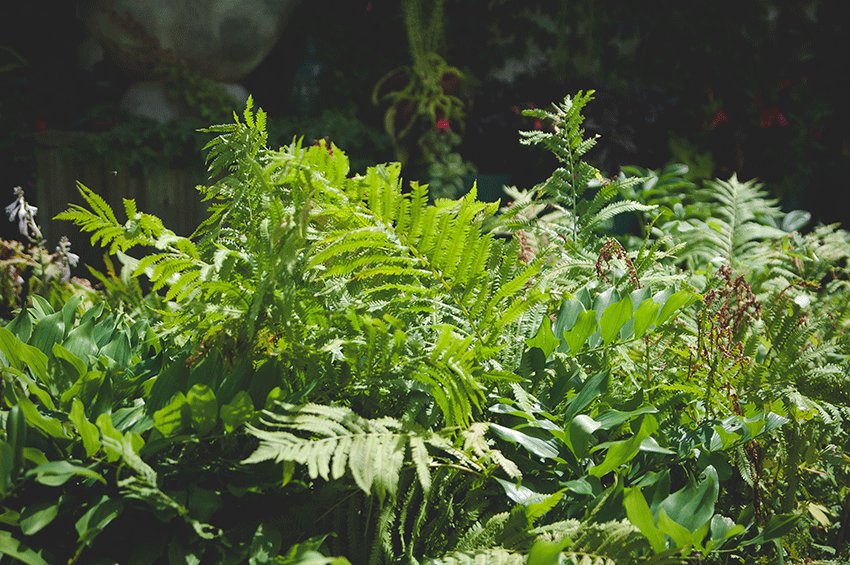Inside\Within is a constantly updating web archive devoted to physically exploring the creative spaces of Chicago's emerging and established artists.
Support for this project was provided by The Propeller Fund, a joint administrated grant from Threewalls and Gallery 400 at The University of Illinois at Chicago.

Search using the field below:
Or display posts from these tags:
3D printing 3D scanning 65 Grand 7/3 Split 8550 Ohio 96 ACRES A+D Gallery ACRE animation Art Institute of Chicago Arts Incubator Arts of Life audio blogging Brain Frame CAKE Carrie Secrist Gallery casting ceramics Chicago Artist Writers Chicago Artists Coalition Chicago Cultural Center Cleve Carney Art Gallery Clutch Gallery Cobalt Studio Coco River Fudge Street collage collection Columbia College Chicago Comfort Station comics conceptual art Contemporary Art Daily Corbett vs. Dempsey Creative Capital DCASE DePaul University design Devening Projects digital art Dock 6 Document drawing Duke University dye Elmhurst Art Museum EXPO Chicago Faber&Faber fashion fiber Field Museum film found objects GIF Graham Foundation graphic design Harold Washington College Hatch Hyde Park Art Center illustration Image File Press Imagists Important Projects ink installation International Museum of Surgical Science Iran Jane-Addams Hull House Museum jewelry Joan Flasch Artist's Book Collection Johalla Projects Julius Caesar Kavi Gupta Links Hall Lloyd Dobler LVL3 Mana Contemporary metalwork Millennium Park Minneapolis College of Art and Design Monique Meloche Museum of Contemporary Art Chicago (MCA) Museum of Contemporary Art Detroit (MOCAD) Museum of Contemporary Photography (MoCP) National Museum of Mexican Art (NMMA) National Resources Defense Council New Capital Northeastern Illinois University Northwestern University Ox-Bow painting paper mache Peanut Gallery peformance Peregrine Program performance photography PLHK poetry portraiture printmaking public art Public Collectors publications Renaissance Society risograph rituals Roman Susan Roots&Culture SAIC screen printing sculpture Sector 2337 Shane Campbell Silver Galleon Press Skowhegan Slow Smart Museum Soberscove Press social practice South of the Tracks Storefront SUB-MISSION Tan n' Loose Temporary Services Terrain Terrain Biennial text-based textile textiles The Banff Centre The Bindery Projects The Cultural Center The Franklin The Hills The Luminary The Packing Plant The Poetry Foundation The Poor Farm The School of the Art Institute of Chicago (SAIC) Threewalls Tracers Trinity College Trubble Club University of Chicago University of Illinois at Chicago (UIC) University of South Florida at Tampa Valerie Carberry Vermont Studio Center video weaving Western Exhibitions wood carving woodwork Yellow Book Yollocalli Arts Reach zinesInside\Within is produced in Chicago, IL.
Get in touch:
contactinsidewithin@gmail.com
Aimée Beaubien’s Woven Imagery

Collecting images like objects, Aimée slices her photographic documentation into pieces that are then woven into large three-dimensional forms. These works, which often hang collectively from the ceiling, are filled with information and bits of data from friends, family, and strangers’ personal collections. By intricately collaging the photographs Aimée allows personal histories to align with those from collected sources, using photographs taken at places such as the Roger Brown Study Collection and Museum of Contemporary Photography.
I\W: Could you talk a bit about your source imagery for your collages? Are they typically photographs that you take yourself?
AB: Approximately 99 percent of the images I use in my collages are photographs I take myself. From time to time however I do incorporate some images that my great grandmother made. She made photographs every day of her life, and I inherited her archive, which dates all the way back to 1910. She had this collage on her fridge while I was growing up as a kid that has subconsciously influenced every single artistic move that I have made in my practice. Every once in awhile I will rephotograph her pieces, or just include originals in my installations. She was my primary influence, and was the first to teach me about collage. I keep returning to her work because it was such a potent part of my visual vocabulary as a child.
I\W: How did your residency at the Roger Brown Study Collection influence your practice?
Well, this particular installation that I have in my house was compiled from images I took within the collection. I spent an entire year moving in and out of the collection in both of his homes in Lincoln Park and New Buffalo, Michigan. Brown and his partner were really ambitious collectors, and collected everything from popular culture to really amazing outsider art. He also had all sorts of indigenous crafts from all over the world. His tastes were wild and all over the place. It has been fun for me to consider how his personal collection informed the decisions he made in his own production, how my personal collection informs what I do, and then how most artists implicitly collect, even the ones that consider themselves minimalists.
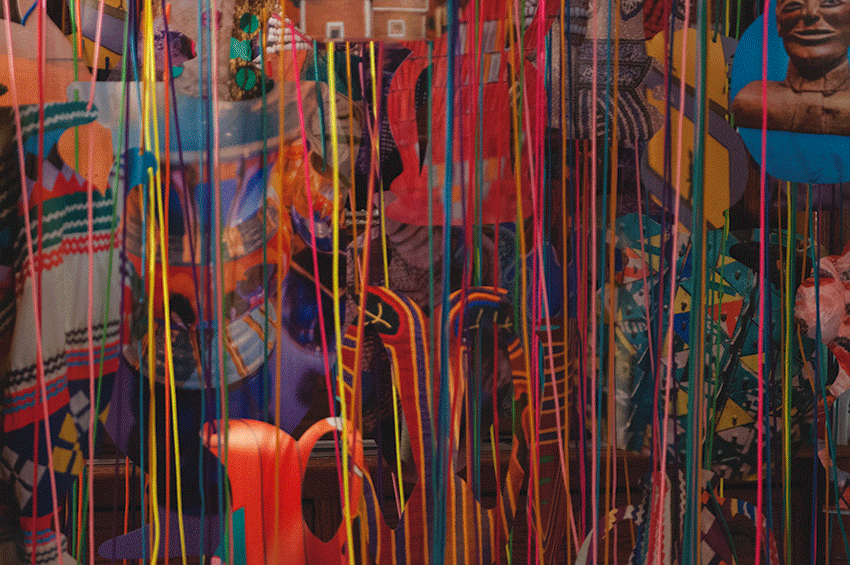
I\W: Was this the experience that inspired your piece at the Museum of Contemporary Photography for their 40th anniversary exhibition?
I wanted that installation to look like a cabinet of wonder and to be thick with material. That was my experience being in Roger’s space. There is just work that covers the space from floor to ceiling. It is all so overwhelming and exciting and dense. I really tried to capture that feeling or that intensity. The piece was an iteration of what is currently in my home but much, much larger. The final installed work was 11 feet tall, 9 feet wide, and 3 feet deep. I condensed it for this space when it returned to my studio, but here is where I really worked it out before it was installed in order to get a sense of how much material I needed.

I\W: How did you incorporate your own collection into the installation to mirror Roger Brown’s?
Well, the museum exhibition was specifically about highlighting and celebrating 40 years of their own collection, so when they invited me to do this site-specific piece, I just started thinking about what aspects of the history of photography were most important to me. I always go back to William Henry Fox Talbot and these photographs he took of his personal collection. Also, my work was installed in the museum’s stairwell which was important for me because of the separation my stairwell in my home provides. It is a link and divide between my studio space and my living space with my husband. Our stairwell is covered with my husband’s whiskey jugs, so everything came together when I started to think of these vessel forms I walk past daily on my staircase in relationship to the vessels in Talbot’s still lifes. I then began connecting them to my images of Roger Brown’s collection and started considering my photographs as these vessels of memory. So I began cutting silhouettes of vessels into photographs.
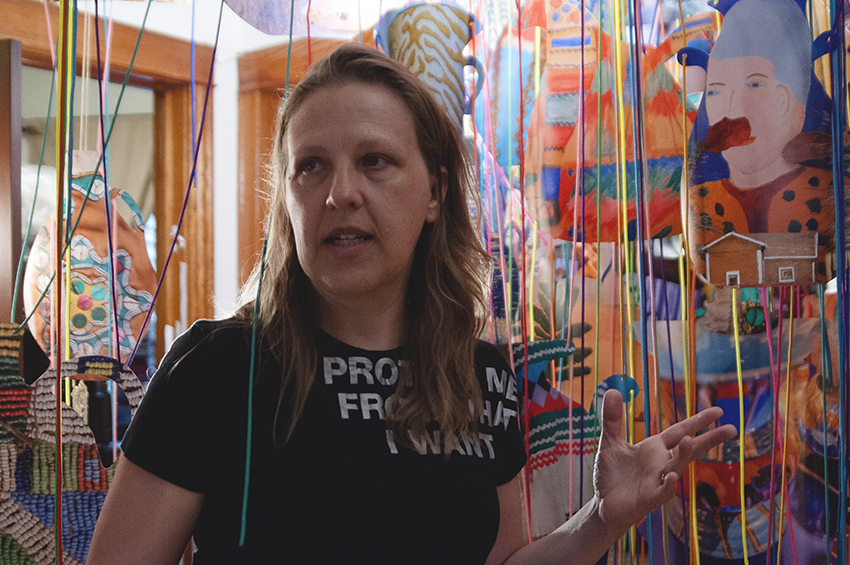
I\W: You are layering diverse histories within your collage, including your own. However each of the works ends up being so bright and joyful. Is that an intention in your installations, or is that just what your eye is drawn to when photographing the world?
I manipulate the color within my photographs. I tend to gravitate towards bright color palettes, but I’m also pushing my works towards them as well through digital manipulation. A lot of that has to do with these colors I am discovering in my great grandmother’s work, especially as the works age. They have a really warm past. When I first worked in photography I was working in the dark room. I was drawn to color and would apply it to the monochromatic work, but I didn’t really know how to incorporate it fully. When I made the transition to digital I went crazy and I remain super interested in experimenting with color.
For me, my woven images are weird metaphors for these digital processes I don’t seem to fully understand. I am physically pulling the images apart and then putting them back together again.
I\W: Can you talk about your process when creating your 3D collaged forms? How did your work move from 2D to 3D?
Some of the 3D work came out of a project I created at DEMO Project in Springfield, IL, which I consider my very first site-specific installation. While preparing for the exhibition I was noticing how my domestic studio environment was influencing the decisions I was making in my work, and I was excited about having a house as an actual site for the exhibition. For that show I created this huge pile of furniture and then built a giant beanstalk. It looked as if it was growing and overtaking everything, which was based on some things that were happening in my backyard. I had let some vines get out of control because I was interested in watching their woven patterns and observing how they overtook other plant life. I was also reading JG Ballard’s post-apocalyptic novel The Drowned World that he wrote in the 1960’s. I was excited about the chaos of a domestic space being overtaken by this natural form. That prompted this whole weaving of the image thing, which started last summer.
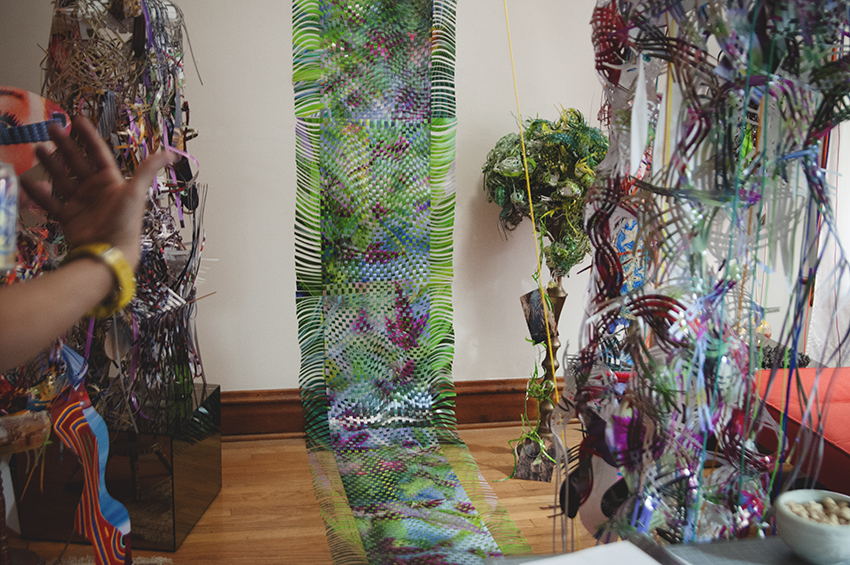
I\W: Why did you decide to weave the images together?
Right before the exhibition at DEMO Project I had visited Santa Fe, NM. I went to a gallery recommended by a friend that had these amazing baskets and I asked if I could photograph them. I spent hours doing this, but couldn’t figure out what to do with these photographs. I decided to just cut them apart and weave them back together into basic basket forms. I am really confused about how to visually understand the way digital information is captured and converted into 1’s and 0’s and then turned back into an image again. For me, my woven images are weird metaphors for these digital processes I don’t seem to fully understand. I am physically pulling the images apart and then putting them back together again.
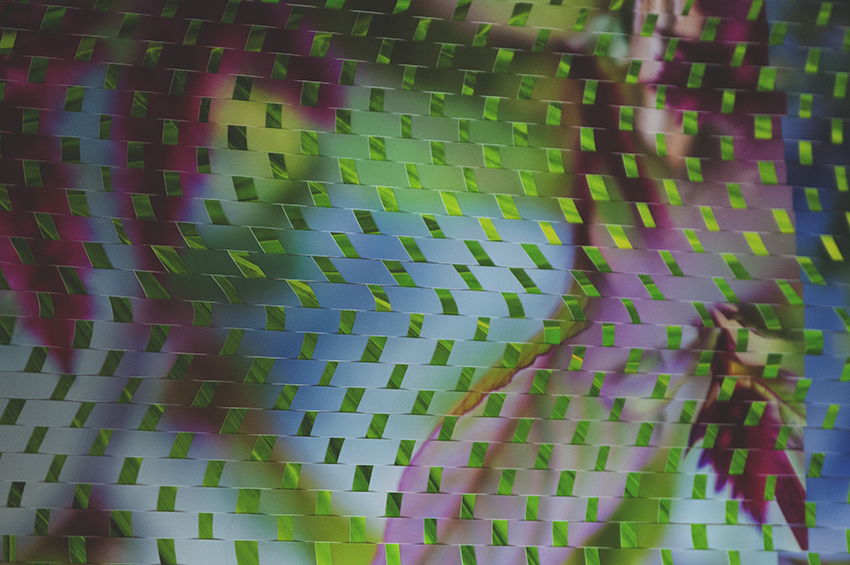
I\W: Why do you choose to leave untouched photographic moments in your work alongside the more sculptural pieces?
One thing that is interesting to me is how frequently people who are active viewers of collage automatically leap to the conclusion that it is appropriated imagery. I totally get that based on the history of collage and the way that I often photograph other people’s artwork, so there is definitely a nod to appropriation, but they are still my photographs, and they still are radically different from what the original source image may have been. I thought about experimenting with this idea of potentially reintroducing more whole moments from my photographs. I don’t really know what this is yet. It is a newer impulse that I feel is an outgrowth of this satisfaction in making the vessel forms. I think I am trying to figure out if I would be comfortable making a rectilinear photograph which I have not done for a very long time. Or is it more exciting for me to cut forms out of my rectilinear photographs? How much can I cut away? When do you recognize the form as a photograph? When is it just material? For me there is so much meaning in the making of these things. I think that it is a really charged visual experience to make them, but to also view them and experience them.
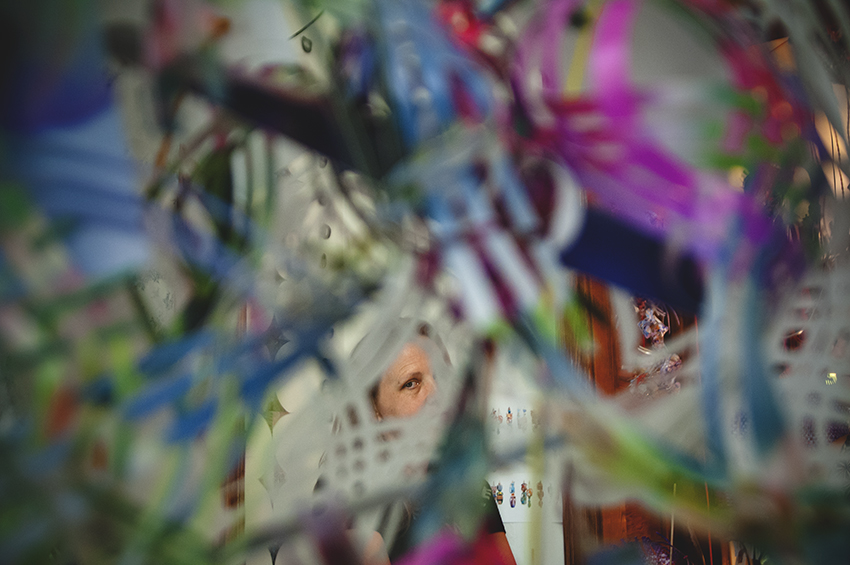
I\W: Now that you have been making the sculptural forms with your photographs, does this influence how you capture the original image?
Totally. I think that is why I play so much with shallow depth of field. I think about an out of focus area more as fabric. I think everything really shifted for me when I did a residency in Austria and it happened to coincide with the Venice Biennale. I decided to spend a week there photographing. I thought I would just make photographs as documentation of exhibitions to share with my students, and then I noticed I was taking photographs in really weird ways. I wasn’t documenting the shows. I was really interested in the intersections between the contemporary art and then this really robust decorative palace. It was such an incongruous and exciting meet-up for me. I decided that this could be material to make work from. I started photographing things differently because I was already anticipating cutting them up.
